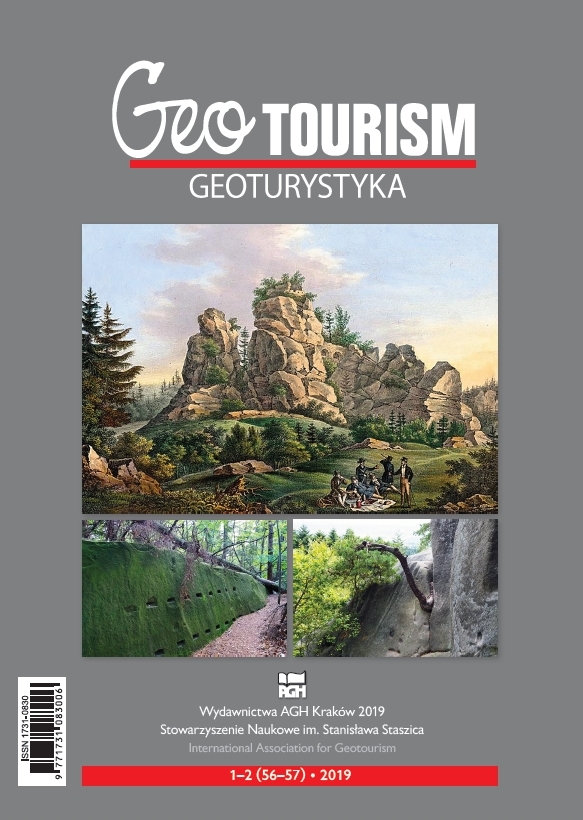Geotouristic aspects of the Geopark Cabo de Gata-Níjar (Andalusia, Spain)
DOI:
https://doi.org/10.7494/geotour.2019.56-57.1Keywords:
geotourism, mining heritage, geopark, Cabo de Gata, RodalquilarAbstract
The Cabo de Gata-Níjar Geopark is one of the most remarkable examples of the geological heritage in Spain, and it comprises the largest volcanic massif in Andalusia. It is built of andesites and dacites with such typical volcanic forms like lava flows, volcanic calderas, volcanic domes and columnar joints. The ancient beaches and reefs demonstrate the presence of climate change as well as of a subtropical sea. The tourism in this region is mainly focused on its beaches and some remains of the cultural heritage, like salt works or the Rodalquilar gold mine. This study pretends to analyze the reasons and consequences of this matter. Highlighting the good state of preservation of this area and the possibility of enjoyment of its beauty, more attention should be paid to the popularization of the local geological aspects, which would significantly increase the awareness and interest among the tourists.
Downloads
References
Díaz Álvarez J.R., 1983. La Provincia de Almería: El soporte físico del espacio geográfico. Almería, t. I. Editorial Andalucía de Ediciones Anel, Granada.
Gil Albarracín A., 2001. Guía del Parque Natural Cabo de Gata-Níjar (Almería). Griselda Bonet Giraber, Granada.
Feixas C., 2003. The Rodalquilar gold. In: Villalobos Megía M. (ed.), Geology of the Arid Zone of Almeria, South East Spain. An educational field guide. State water Company for the Southern Basin S.A. (ACUSUR): 34‒36.
Fernández J.M., 2003. The Cabo de Gata Volcanic Complex. In: Villalobos Megía M. (ed.), Geology of the Arid Zone of Almeria, South East Spain. An educational field guide. State water Company for the Southern Basin S.A. (ACUSUR): 29‒31.
Labus M., 2009. Geologia Almerii – półpustynnej krainy Hiszpanii (Geology of Almería – semi-desert zone of Spain), Geoturystyka, 1–2 (16–17): 33–40.
Martín Escorza C., López Ruiz J., 1988. Un modelo geodinámico para el volcanismo neógeno del sureste ibérico. Estudios Geológicos, 44: 243–251.
Mather A.E., Martin J.M., Harvey A.M., Braga J.C., 2001. A Field Guide to the Neogene Sedimentary Basins of the Almeria Province, South-East Spain. Blackwell Science.
Mendoza Castellón R., 2008. Cabo de Gata: veinte años desde la declaración del Parque Natural Cabo de Gata-Níjar. Ministerio de Agricultura, Alimentación y Medio Ambiente, Secretaría General Técnica. Servicio de Publicaciones y Divulgación, Almería.
Mendoza M.R., Rivas P., Navarro Pastor J., Serna A., Pérez Villalba M., 2008. Geoparques andaluces, un ejemplo en la protección de la geodiversidad. Medio Ambiente, 62:12–15.
Moreno Lampreave D., 2001. El espectacular patrimonio natural litoral y sumergido de Cabo de Gata (España). In: Moreno D., Frias A. (eds.), Actas de las I Jornadas sobre Reservas Marinas y I Reunión de la Red Iberoamericana de Reservas Marinas (RIRM). Cabo de Gata, Almeria, 17–23 de septiembre de 2001. Secretaria General de Pesca Maritima, Madrid, 25–46.
Muñoz Muñoz J.A., Ruiz García A., 2002. Itinerario por Cabo de Gata y Campos de Níjar. La cultura del agua como aproximación histórica y etnográfica. Consejería de Educación y Ciencia. Consejería de Cultura. Junta de Andalucía.
Rigol J.P., Chica-Olmo M., 1998. Merging remote-sensing images for geological-environmental mapping: application to the Cabo de Gata-Níjar Natural Park, Spain. Environmental Geology, 34: 194–202.
Rytuba J.J, Arribas Jr. A., Cunningham C.G., McKee E.H., Podwysocki M.H., Smith J.G., Kelly W.C., Arribas A., 1990. Mineralized and unmineralized calderas in Spain; Part II, evolution of the Rodalquilar caldera complex and associated gold-alunite deposits. Mineralium Deposita, 25: 29–35.
Toscani L., Venturelli G., Barbieri M., Capedri S., Fernandez Soler J.M., Oddone M., 1990. Geochemistry and petrogenesis of two-pyroxene andesites from Sierra de Gata (SE Spain). Mineralogy and Petrology, 41: 199–213.
Villalobos Megía M., Pérez Muñoz A.B., Braga Alarcón J.C., 2007. Geodiversity and geological heritage of Andalusia. Geological excursions through Andalusia an educational guide. Regional Ministry of Environment, Junta de Andalusia.
www1 – http://www.juntadeandalucia.es/medioambiente/portal_web/web/temas_ambientales/espacios_protegidos/01_renpa/canales_figuras_proteccion/GEOPARQUES/2017_01_geoparques/cabo_gata/conoce_el_geoparque_cgn/mapa_conoce_cabo_de_gata.png [accessed: 2019.09.20].
Downloads
Published
Issue
Section
License

The content of the journal is freely available according to the Creative Commons License Attribution 4.0 International (CC BY 4.0).


